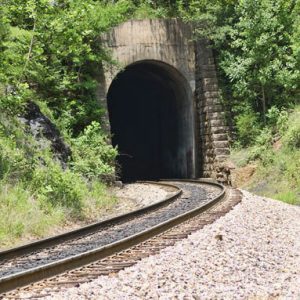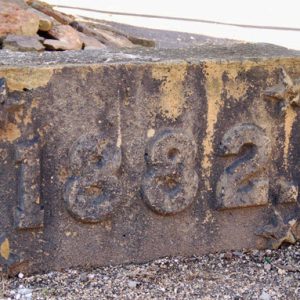calsfoundation@cals.org
Winslow Tunnel
In September 1880, the St. Louis–San Francisco Railway Company (Frisco) created a railroad subsidiary, the Missouri, Arkansas and Southern Railway of Arkansas. The new subsidiary was authorized “to build in a southerly direction”—likely from Fayetteville (Washington County)—“to some point on the Little Rock & Fort Smith Railway, not east of Clarksville, with total mileage of about 55 miles.” The Little Rock and Fort Smith (LR&FS) in 1876 began rail service between Argenta—now North Little Rock (Pulaski County)—and Van Buren (Crawford County). The broad language of the authorization clearly reflected the uncertainty in constructing a railroad line through the Boston Mountains range of the Ozark Mountains, the highest range between the Alleghenies and the Rockies. The range, the highest elevation of which is almost 2,600 feet, runs from east to west, unlike other ranges that follow a north-south orientation. The western end was in Indian Territory (present-day Oklahoma), where new railroad construction was then prohibited by Congress.
Construction of a tunnel at Summit Home—now Winslow (Washington County)—was the most feasible way to reach Fort Smith (Sebastian County). The Missouri, Arkansas and Southern Railway of Arkansas drew up detailed plans for the “Boston Mountain Tunnel” and let a contract for the tunnel project. Tunnel work began on September 26, 1881, after the Missouri, Arkansas and Southern of Arkansas merged into the Frisco-controlled St. Louis, Arkansas and Texas Railway Company. The first task was to remove overburden—dirt and rock—on the tunnel faces from both ends to minimize the actual amount of tunnel work. The tunnel site, located at an elevation of about 1,700 feet, was located about 185 feet below a ridge. The workers encountered black rock that some thought indicated the presence of coal. However, the coal-like rock was unstable shale prone to collapse when exposed to air.
An urgent priority was construction of a temporary switchback railroad that would enable trains to operate over the Boston Mountains while tunnel construction was under way. The trains were needed to carry iron for the three trestles being built south of the planned tunnel and supplies for the track-laying crews. Work began on the switchback railroad in November 1881, some three months after Summit Home changed its name to Winslow to honor Frisco president Edward F. Winslow. Construction of the switchback railroad was a major undertaking. The switchback had one section where the grade exceeded four percent per mile. The switchback also had a 500-foot-long wooden trestle. A newspaper reported the switchback as nearly complete in March 1882.
A major problem was the lack of medical services in this remote area. Tunnel workers, who used pneumatic tools, suffered from a lack of fresh air, leaving their complexions sallow. In early 1882, an outbreak of smallpox swept through the tunnel workforce of 300 men and caused dozens of deaths. Untreated smallpox has a mortality rate of up to thirty percent. With the return of warm weather, malaria became common. Each death was marked by the sounding of a train whistle, according to an eyewitness. Black laborers were buried in four area graveyards, one called the “African Center,” while the whites were laid to rest in a whites-only graveyard. The workers also dealt with racial tension. The north end of the tunnel was built by whites; the south end was the province of black workers. Fights between the two groups caused several fatalities, according to an eyewitness observer.
The first contractor failed to make progress and, in March 1882, was replaced by the firm of Cameron and Halby. Tunneling from both ends progressed at a combined rate of seventy-five feet per week in optimum conditions. By the last day of May 1882, the two faces were 428 feet apart. The tunnel was lined with thick oak support beams. Cuttings for the tunnel faces were completed in June 1882, along with a thirty-foot brick portal at each end of the tunnel.
The 1,693-foot-long tunnel was finished in July 1882 and opened to rail traffic the next month. The tunnel, the longest of the three on the Frisco system, cost about $200,000 to construct, a very large sum in 1882. The 1882 Frisco Annual Report stated that the “Winslow tunnel was the most expensive and difficult part of the work” in building the Arkansas Division to Van Buren. Indeed, the persistent problem of collapses of the soft shale that blocked the line necessitated lining the tunnel with brick. This work was done in 1898–99 at a cost in excess of $43,000 and probably increased the tunnel to its current length of 1,702 feet.
In 1967, the Frisco hired the construction firm of Morrison Knudsen Corporation to enlarge the tunnel. The $1.5 million project increased the height to twenty-four feet and the width to nineteen feet to permit the use of larger freight cars. A principal challenge was replacing a massive brick lining that the Frisco installed in the Winslow Tunnel in 1898 and 1899. During the renovation, freight trains continued to operate from Fort Smith to Monett, Missouri.
When the Winslow Tunnel was enlarged in 1967–1969, the large limestone 1882 date stones over the two portals were removed. The north portal date stone was destroyed. The south portal date stone survived and was taken home to Springfield, Missouri, by a Frisco employee. It passed through several hands before being returned to downtown Winslow on November 14, 2007, by the Arkansas and Missouri Railroad, which today operates passenger and freight trains through the Winslow tunnel.
For additional information:
Burgess, W. A. “Building the Frisco Roadbed in Northwest Arkansas.” Arkansas Historical Quarterly 10 (Autumn 1951): 268–284.
Burns, Thomas. “On First Engine Thru Boston Tunnel.” Frisco Employees Magazine, October 1931, p. 14. Online at http://thelibrary.org/lochist/frisco/magazines/fem_1931_10/fem_1931_10.cfm (accessed February 5, 2024).
“New Dimensions For Brick-Lined Railroad Tunnel.” EM-Kayan Magazine (December 1967): 8–9.
Tom Duggan
Lowell, Arkansas
 Transportation
Transportation Winslow Tunnel
Winslow Tunnel  Winslow Tunnel Date Stone
Winslow Tunnel Date Stone  Winslow Tunnel
Winslow Tunnel 




Comments
No comments on this entry yet.